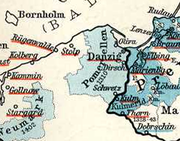
Treaty of Soldin
Encyclopedia

Myslibórz
Myślibórz is a city in north-west Poland, in West Pomeranian Voivodeship. It is the capital of the Powiat of Myślibórz...
by Waldemar, Margrave of Brandenburg-Stendal
Waldemar, Margrave of Brandenburg-Stendal
Waldemar of Brandenburg was Margrave of Brandenburg-Stendal, the last from the Ascanian House.-Life:He was a son of Conrad, Margrave of Brandenburg-Stendal and Constance, daughter of Przemysł I of Greater Poland...
, and the Teutonic Order.
In 1308 the Order had agreed to help Polish forces retake the city of Danzig (Gdańsk) from the Brandenburgians, in exchange for being allowed to garrison a nearby fort for a year. However, during the siege disputes arose as to the extent of the fort that was to be loaned to the Teutonic Knights, and after being seized and briefly imprisoned, the Polish troops departed the siege. After they captured the city, the Teutonic Knights massacred its inhabitants and took the town for their own.
However, the Order still lacked any legal basis for their possession of Danzig. As a result they purchased these from Brandenburg, as well as the rights to most of Pomerelia
Pomerelia
Pomerelia is a historical region in northern Poland. Pomerelia lay in eastern Pomerania: on the southern shore of the Baltic Sea and west of the Vistula and its delta. The area centered on the city of Gdańsk at the mouth of the Vistula...
(Dirschau (Tszew), Schwetz (Świecie) and their hinterlands) for 10,000 silver Mark
Mark (money)
Mark was a measure of weight mainly for gold and silver, commonly used throughout western Europe and often equivalent to 8 ounces. Considerable variations, however, occurred throughout the Middle Ages Mark (from a merging of three Teutonic/Germanic languages words, Latinized in 9th century...
, despite the fact that the initial claims to Danzig and surrounding areas by Brandenburg were themselves of dubious legality.
The treaty was subsequently confirmed in 1311 by Emperor-elect Henry VII
Henry VII, Holy Roman Emperor
Henry VII was the King of Germany from 1308 and Holy Roman Emperor from 1312. He was the first emperor of the House of Luxembourg...
, but repeatedly questioned by Poles, resulting in the Polish-Teutonic Wars.
In the Treaty of Kalisz (1343), the Polish king finally recognized the territorial changes.
The treaty gave the Teutonic Order control of the lower Vistula
Vistula
The Vistula is the longest and the most important river in Poland, at 1,047 km in length. The watershed area of the Vistula is , of which lies within Poland ....
, a direct access to the Baltic Sea
Baltic Sea
The Baltic Sea is a brackish mediterranean sea located in Northern Europe, from 53°N to 66°N latitude and from 20°E to 26°E longitude. It is bounded by the Scandinavian Peninsula, the mainland of Europe, and the Danish islands. It drains into the Kattegat by way of the Øresund, the Great Belt and...
through Danzig, and a continuous route into the Holy Roman Empire
Holy Roman Empire
The Holy Roman Empire was a realm that existed from 962 to 1806 in Central Europe.It was ruled by the Holy Roman Emperor. Its character changed during the Middle Ages and the Early Modern period, when the power of the emperor gradually weakened in favour of the princes...
. The same year the treaty was signed, the order's headquarters were moved from Venice
Venice
Venice is a city in northern Italy which is renowned for the beauty of its setting, its architecture and its artworks. It is the capital of the Veneto region...
to Marienburg
Marienburg
-The historical German names of these places:*Ordensburg Marienburg , the large brick castle built by the Teutonic Knights**Malbork, Poland, site of the Ordensburg Marienburg, formerly Marienburg in Westpreußen and during World War II, Nazi Stalag XX-B for enlisted men*Alūksne, Latvia*Feldioara,...
(Malbork).

